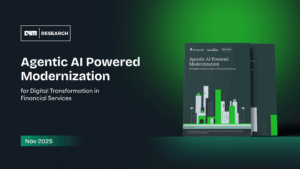The realm of AI has long been bathed in the glow of promise and anticipation, where lofty expectations often outshine the pragmatic realities. Now, as the dust settles on the initial excitement surrounding Generative AI (GenAI), companies find themselves at a crossroads. The buzz has subsided, replaced by a sober assessment of what GenAI truly offers, what challenges it presents, and how to navigate this technology’s adoption in a more pragmatic, measured manner. This post-hype era compels organizations to explore realistic approaches toward integrating GenAI into their operations, focusing on practicality, feasibility, and tangible benefits.
We had a roundtable discussion to get a better understanding on what the leaders think of the post – hype reality revolving around Generative AI. To give us more insights we had with us EJ Kim, Business Transformation & Growth Strategy Executive, Virag Masuraha, Managing Director, Global Head of Fraud Analytics and Modeling at Citi, Rama Kattunga, Head of Data and Analytics at Samsung Electronics, Rishi Bhatia, Director Data Science at Walmart Global Tech and Maharaj Mukherjee, Senior Vice President and Senior Architect Lead at Bank of America.
Exploring the Real-Life Impact of Generation AI: Navigating the Balance between Enthusiasm and Pragmatism with a Forward-Thinking Approach
Generation AI is a sophisticated tool; it’s a game-changer, but it’s not a vending machine. Our daily interactions with ChatGPT are based on historical data and what we do with it today will shape the future potential of this technology. Automation that tangibly boosts efficiency is truly exciting, but its potential goes beyond. Now is the time for organizations to invest smartly, focusing on governance, learning, testing, and experimenting. Neglecting proper data cleaning and training? That’s a future pitfall. The concept is simple – good input equals good output. Also, we have to keep in mind the accessibility of this technology comes with responsibility, which requires thoughts and standards.
I am currently optimizing GenAI but with future gains in mind. I am considering priorities such as redefining talent needs, instituting new processes and developing new standards. These considerations are both challenging and exciting —a puzzle to solve, which I am very much looking forward to…aiming to responsibly unlock GenAI’s full potential and make a substantial impact in the long run.
– EJ Kim, Business Transformation & Growth Strategy Executive
Transitioning from Hype to Foundation: Strategies for Industry Leadership and Organizational Evolution
Fraudsters are financially incentivized to adopt newer technologies much more promptly. Within Fraud Prevention we are closely observing and studying the downside of AI adoption. We are required to remain alert and concerned about the risks that these technologies will bring. It is often not a single technology but a combination of several associated technologies that make for a potent weapon in the hands of fraudsters. The data compromises are increasing, and fraudsters are connecting these dots using both structured and non-structured data. Gen AI technologies provide bad actors with the ability to manipulate unstructured data, text, video, and voice. These data technologies in combination make it a prized possession for fraudsters to exploit vulnerabilities on an unprecedented scale.
As fraud prevention practitioners, we actively anticipate the risks of combining these technologies. The next step is to actively plan defenses – short, medium, and long run. For example, in recent years, most FIs have started on a path to passive authentication using voice, video, and other digital signals. Gen AI provides capabilities to replicate these passive signals and therefore enhances fraud risks from the adoption of passive authentication tools and technologies. One of the active controls would be to consider multi-layered analog controls that are not susceptible to easy replication. Over time, actively considering the use of ethical AI to counter fraud risk from unethical use of Gen AI would be much more warranted.
– Virag Masuraha, Managing Director, Global Head of Fraud Analytics and Modeling at Citi
Aligning Technological Solutions with Stakeholder Needs: Bridging the Gap Between Expectations and Implementation
It provides ample room for innovative ideas to flourish. Can we achieve that? Given the nascent stage of this evolving industry, certain tasks may not be feasible immediately but hold potential for the future. For instance, when this initiative commenced, there was a demand for tabular data in reports, along with a desire to include financials. However, caution is essential, especially when dealing with financial data. Rigorous validation frameworks must be established to ensure accurate numbers. A compelling use case, albeit somewhat tangential, involves addressing customer complaints and reviews. If Gen AI can distill information on specific items and provide actionable feedback on identified issues, it could significantly enhance our operations. This not only streamlines response times but also improves customer satisfaction.
The primary challenge lies in maintaining excellent data quality, a recurring concern in analytical science. This is particularly crucial in the context of Gen AI, where data quality must be exceptionally high. Another key consideration is the seamless integration of Gen AI with existing systems.
Moreover, it’s important to acknowledge the learning curve for data scientists within the organization. Despite having individuals with advanced degrees, the adoption of these technologies necessitates ongoing learning and implementation efforts.
– Rishi Bhatia, Director Data Science at Walmart Global Tech
Exploring the Limitations and Potential of Generative AI: Embracing Nuances and Understanding Use Cases
I am, personally, looking at the popular LLM based chatbots more enthusiastically than a year ago. There are areas where these solutions can be very useful if somebody, a human, guides them. They can be a very powerful tool with some human guidance and cannot be used as is. These LLM based chatbots, as we all know, have a very different purpose from a search engine and may not be used as one. Another fundamental limitation of the generative AI is that once you build the foundational model, it can only fit in some AI use cases for customizations. A foundational model built for one purpose or one organization, at least at this point, cannot replace another foundational model.
These LLM models are subject to the same limitations as any other AI models such as model errors and model decays. Using some anthropomorphic terms such as “hallucinations” does not make these chatbots humans or does not make their errors go away. No, these are just purely simple errors. Why do we have to consider they are humans and call them errors and hallucinations. Also, these LLM models are still not creating anything new and fundamental. They do lack the originality of human beings. As long as we understand its limitations and as long as we know how we can use it they can become very powerful tools for all sorts of purposes.
– Maharaj Mukherjee, Senior Vice President and Senior Architect Lead at Bank of America
This article is written by a member of the AIM Leaders Council. AIM Leaders Council is an invitation-only forum of senior executives in the Data Science and Analytics industry. To check if you are eligible for a membership, please fill out the form here.





